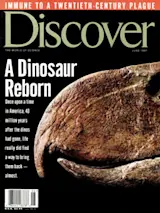Titan, Saturn’s largest moon, hides its surface beneath an orange haze. The haze, scientists believe, results from the breakdown of methane in Titan’s atmosphere by ultraviolet light from the sun. Yet the ultraviolet radiation should have destroyed Titan’s methane long ago. Some researchers have speculated that evaporating gas from methane oceans on the moon’s surface might replenish its atmosphere. But Ralph Lorenz, a planetary scientist at the University of Arizona, says recent data seem to rule out this scenario. It’s quite clear from radar data and Hubble Space Telescope images that Titan is not completely covered with liquids. If there are any methane oceans there, he notes, they don’t contain enough methane to solve the problem. Lorenz says he may have a better explanation for the moon’s mysteriously persistent atmosphere. The moon may periodically lose and rebuild its atmosphere.
Lorenz and a colleague created a computer model of Titan’s atmosphere. ...














